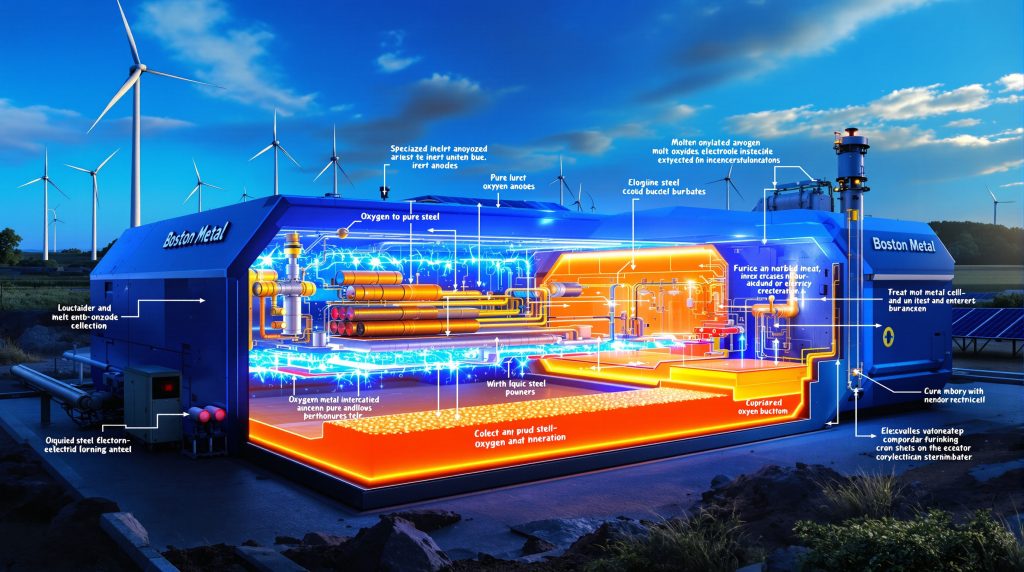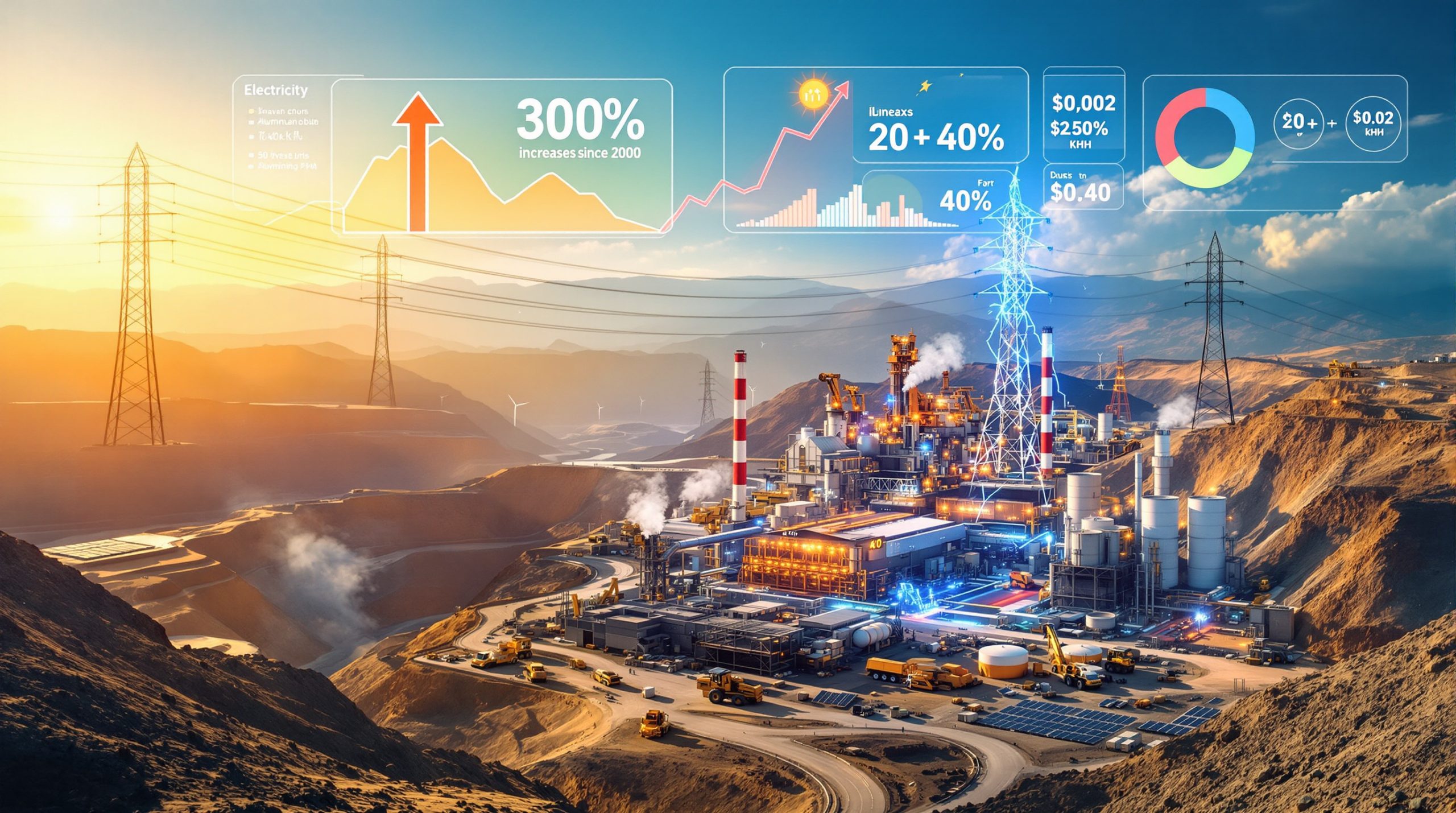Boston Metal's Revolutionary Carbon-Free Steel Production Technology
Molten Oxide Electrolysis (MOE) represents a groundbreaking approach to steelmaking that fundamentally reimagines the traditional process. This innovative technology uses electricity rather than carbon to separate iron from oxygen in iron ore, creating a direct path from ore to metal without the carbon-intensive steps of conventional steelmaking.
The process operates within specialized modular cells approximately the size of a school bus, each capable of producing around 10 tons of metal daily. Inside these cells, an electrolyte solution is heated to approximately 1600°C, creating the molten environment necessary for the reaction. Iron ore or other metal oxides are then introduced into this superheated bath.
The Electrochemical Process Explained
The core of the MOE technology involves:
-
Electrode Configuration: The system employs specially designed inert anodes immersed in the molten oxide electrolyte
-
Electrical Current Application: When electricity flows through the system, it drives the separation of metal from oxygen
-
Oxygen Evolution: Oxygen gas is released at the anode as a clean byproduct
-
Metal Collection: Pure liquid metal forms at the bottom of the cell, ready for further processing
This direct electrochemical approach eliminates multiple energy-intensive and polluting steps in traditional steelmaking, including coking, sintering, and blast furnace operations. The technology was originally developed by Massachusetts Institute of Technology researchers Donald Sadoway, Antoine Allanore and James Yurko, with MIT licensing the pioneering anode technology to Boston Metal in 2012.
Why is Carbon-Free Steel Production Revolutionary for Climate Goals?
The Environmental Impact of Traditional Steelmaking
Steel production has historically been one of the most carbon-intensive industrial processes, responsible for approximately 7-9% of global CO2 emissions. Conventional methods rely heavily on coal-derived coke as both a fuel and reducing agent, making decarbonization extremely challenging.
For each ton of steel produced through traditional blast furnace methods, approximately 1.8-2 tons of CO2 are released into the atmosphere. With global steel production exceeding 1.9 billion tons annually, the environmental footprint is enormous.
MOE's Environmental Advantages
Boston Metal's technology offers several transformative environmental benefits:
| Environmental Factor | Traditional Steelmaking | Boston Metal's MOE |
|---|---|---|
| Direct CO2 Emissions | 1.8-2 tons per ton of steel | Zero (when powered by renewables) |
| Process Byproducts | CO2, sulfur compounds, particulates | Only oxygen |
| Resource Requirements | Coal, limestone, natural gas | Iron ore and electricity |
| Water Usage | High (cooling, gas cleaning) | Significantly reduced |
| Land Footprint | Extensive (multiple process facilities) | Compact (modular cells) |
When powered by renewable energy in mining, the MOE process becomes truly carbon-free, representing one of the few viable pathways to fully decarbonize steel production without relying on carbon capture or offsetting strategies. As Adam Rauwerdink, senior vice president of business development at Boston Metal explains, the process eliminates coal usage entirely, meaning there are no carbon emissions from the electrolysis process itself.
How is Boston Metal Scaling its Technology for Industrial Application?
Boston Metal has been methodically advancing its technology from laboratory concept to industrial reality through a series of strategic developments and partnerships.
Key Milestones in Technology Development
-
2012: Technology licensing from MIT and company founding
-
2013: First laboratory demonstration of emission-free steel production
-
2014: Commissioning of first semi-industrial MOE cell
-
2022: Beginning of anode testing at Woburn facility
-
March 2025: Commissioning of multi-inert anode MODE industrial cell in Woburn
-
Q4 2025: Expected commissioning of first industrial plant in Brazil
Strategic Partnerships Accelerating Deployment
The company has formed critical partnerships to secure supply chains and advance commercialization:
-
Outokumpu Collaboration (September 2025): This partnership secures chromium oxide and feedstock from Finland's Kemi mine, essential for manufacturing the inert anodes central to the MOE technology.
-
Brazilian Operations: Boston Metal do Brasil is establishing its first industrial plant in Coronel Xavier Chaves, Minas Gerais, focusing on extracting high-value metals from metallurgical waste, including niobium and tin.
These partnerships demonstrate the versatility of the MOE platform beyond just steel production, creating multiple pathways to market and revenue generation. According to Rauwerdink, the Outokumpu agreement represents a strategic element in controlling anode manufacture and securing reliable chrome supply for the long-term advancement of the technology.
What Technical Breakthroughs Has Boston Metal Achieved in Anode Technology?
The inert anode represents the heart of Boston Metal's technological innovation, and recent breakthroughs in this area have significantly enhanced the commercial viability of the MOE process.
Anode Durability Advancements
Recent testing has demonstrated remarkable improvements in anode longevity and performance:
-
Extended Operational Life: The company has achieved multiple-month continuous operation with anodes remaining in pristine condition
-
Commercial Viability: Current projections indicate anodes can last between 1-3 years in commercial operation
-
Multi-Anode Configuration: Successful validation of cells containing multiple anodes, enabling scaling to higher production volumes
Material Science Innovations
The composition of the anodes, primarily chromium-based, represents a significant advance in materials science for high-temperature electrochemistry. The company is now focusing on:
-
Cost Optimization: Refining anode designs to reduce production costs
-
Process Efficiency: Improving the overall energy efficiency of the electrolysis process
-
Scaling Production: Developing manufacturing methods for consistent, high-quality anode production
These technical achievements address what has historically been one of the most challenging aspects of molten oxide electrolysis – creating electrodes that can withstand the extreme conditions while maintaining performance over extended periods. According to Rauwerdink, the company can now run anodes for multiple months and finish a duration of a run with anodes that remain "very, very pristine" compared to their initial state – a critical milestone for commercial viability.
What Are the Economic Implications of Boston Metal's Technology?
Cost Competitiveness Analysis
While specific production cost figures haven't been publicly disclosed, several economic factors suggest Boston Metal's approach could achieve cost parity with conventional steelmaking:
-
Process Simplification: Elimination of multiple energy-intensive steps reduces capital and operational expenses
-
Electricity Costs: As renewable energy prices continue to fall, the economics of electricity-based processes improve
-
Carbon Pricing: As carbon taxes and regulations increase globally, carbon-free production gains economic advantage
-
Premium Markets: Initial deployment can target green premium markets where customers are willing to pay more for carbon-free steel
Potential Market Impact
The technology has several market advantages beyond direct cost considerations:
-
Modular Scalability: The cell-based approach allows for gradual capacity expansion and deployment flexibility
-
Reduced Infrastructure Requirements: No need for coking ovens, sinter plants, or blast furnaces
-
Multiple Revenue Streams: Application to high-value metals recovery creates additional business opportunities
-
Supply Chain Resilience: Reduced dependence on metallurgical coal improves supply security
Boston Metal's current focus confirms this approach, with the company actively working to improve anode design efficiency to reduce production costs and optimize the overall production cost per ton of steel or other ferroalloys.
How Does Boston Metal's Approach Compare to Other Green Steel Technologies?
Several approaches to decarbonizing steel production are being pursued globally, each with distinct advantages and challenges:
| Technology | Carbon Reduction | Technical Maturity | Infrastructure Requirements | Key Advantages | Challenges |
|---|---|---|---|---|---|
| Boston Metal's MOE | 100% (with renewable power) | Advancing to industrial scale | Renewable electricity | Direct one-step process, no carbon | High electricity demand, new infrastructure |
| Hydrogen-Based DRI | 90-95% | Commercial pilots operating | Hydrogen production, storage, transport | Uses existing DRI knowledge | Hydrogen availability and cost |
| Natural Gas DRI + CCS | 50-80% | Commercial | Carbon capture infrastructure | Incremental approach | Partial decarbonization only |
| Blast Furnace + CCS | 30-50% | Pilot stage | Carbon capture infrastructure | Uses existing assets | Limited carbon reduction |
Boston Metal's approach stands out for its potential to achieve complete decarbonization through a direct, one-step process without requiring carbon capture infrastructure or hydrogen production facilities. The technology provides additional flexibility in feedstock compatibility, capable of processing various grades of iron ore that some alternative green steel technologies cannot handle effectively.
What Are the Implementation Challenges and Future Outlook?
Current Implementation Challenges
Despite promising progress, several challenges remain for widespread adoption:
-
Electricity Requirements: The process demands significant electricity, requiring abundant renewable energy
-
Scale-Up Complexity: Moving from demonstration to full industrial scale involves engineering challenges
-
Industry Conservatism: The steel industry has historically been slow to adopt radical new technologies
-
Initial Capital Costs: First-of-kind plants typically have higher capital requirements
Future Development Roadmap
Boston Metal appears to be pursuing a strategic implementation approach:
-
Initial Commercialization: Beginning with high-value metals recovery applications (Brazil)
-
Demonstration Scale: Building larger demonstration facilities to prove industrial viability
-
Strategic Partnerships: Collaborating with established steel producers to facilitate adoption
-
Gradual Capacity Expansion: Incrementally increasing production capacity as technology matures
The company's strategy of starting with high-value metals recovery in Brazil before advancing to steel production demonstrates a phased approach to commercialization. This strategy allows Boston Metal to generate revenue while continuing to refine its core modern mining technology for the larger steel market.
FAQ: Boston Metal's Carbon-Free Steel Production
How does Boston Metal's technology eliminate carbon emissions?
The MOE process replaces carbon-based reduction with direct electrochemical separation powered by electricity. When this electricity comes from renewable sources, the entire process becomes carbon-free, with oxygen as the only byproduct.
Can this technology process all types of iron ore?
Yes, the MOE technology can process various grades of iron ore, offering flexibility in feedstock that some alternative green steel technologies cannot match.
What is the energy efficiency of the MOE process?
While specific efficiency metrics haven't been publicly disclosed, electrochemical processes typically offer high theoretical efficiency. The company continues to optimize energy consumption through anode design improvements and process refinements.
When will carbon-free steel from this technology be commercially available?
Boston Metal is progressing toward commercial deployment, with its first industrial plant for metals recovery expected in late 2025. Commercial-scale steel production would likely follow successful operation of these initial facilities.
How does the quality of steel produced compare to conventional methods?
The MOE process produces high-purity liquid iron that can be directly processed into steel. The electrochemical approach potentially offers superior control over impurities compared to traditional methods, potentially yielding higher-quality steel.
Conclusion: Transforming the Steel Industry Through Electrification
Boston Metal's molten oxide electrolysis technology represents one of the most promising pathways to truly carbon-free steel production. By reimagining the fundamental chemistry of steelmaking through electrification, the company offers a direct route to decarbonization without the compromises inherent in other approaches.
The progress in anode technology, successful demonstration of multi-anode cells, and strategic partnerships for raw material supply indicate that the company is methodically addressing the key technical and commercial challenges of scaling this revolutionary approach.
As global pressure to decarbonize heavy industry intensifies, technologies like Boston Metal's MOE will play an increasingly critical role in meeting climate goals while maintaining the steel production necessary for modern civilization. The critical minerals energy transition and sustainable mining transformation will further accelerate these developments. The coming years will be pivotal as this technology transitions from demonstration to commercial deployment, potentially reshaping one of the world's most carbon-intensive industries through industry innovation trends.
Further Exploration:
Readers interested in learning more about innovations in carbon-free steel production can also explore related educational content on the Fastmarkets website, which offers industry news and analysis on developments in green steel and metals markets.
Looking for the Next Major Mineral Discovery?
Discovery Alert's proprietary Discovery IQ model instantly notifies investors of significant ASX mineral discoveries, turning complex geological data into actionable insights for both short-term traders and long-term investors. Visit Discovery Alert's dedicated discoveries page to understand why major mineral discoveries can lead to exceptional market returns and begin your 30-day free trial today.




